New loose wheel prevention technology was announced in Montreal this week by Loose Wheel Sensors Inc. they released their solution to runaway truck wheels.
First here is a look at how serious the runaway tire issue is….
CTV reported this last year…. TORONTO — Four people were taken to hospital after a wheel flew off a transport truck on Highway 401 and was struck by a vehicle that then set off a chain-reaction collision.
The transport truck was headed eastbound near McCowan Road at around 11:30 p.m. on Tuesday when a set of dual wheels became detached from its trailer.
Ontario Provincial Police say that one of the wheels bounced over a concrete median and ended up in the westbound express lanes. A vehicle then slammed into the wheel and set off a chain reaction collision involving four other vehicles.
wo-17-year-old girls in one of the vehicles involved in the crash were trapped “for some time” after their vehicle became “sandwiched” between two other vehicles, according to the OPP. They were then rushed to hospital with serious but non-life-threatening injuries. Two men in one of the other vehicles were also taken to hospital with minor injuries.
“The drivers that were approaching the wheel that had come to a rest already on the highway really had nowhere to go,” OPP Sgt. Kerry Schmidt told CP24 on Wednesday morning. “This could have easily turned fatal.” He said that the driver has been charged with a detached wheel offence and could face a fine of up to $50,000.
An average 33,000 accidents happen annually because of tires, according to the National Transportation Safety Board.
At least 2,000 of those are blowout-related. However wheel-off related incidents are on the rise as trucking is in Overdrive.
Loose Wheel Sensors Inc. have developed a monitoring system to eliminate hazardous runaway truck and trailer wheels.
Runaway wheels occur by current estimates close to 50,000 times per year in North America.
These dangerous incidents often result in property damage, injury, and tragically, fatalities. The possibility of an escaping wheel is a chief concern of fleet operators and managers across the continent both in terms of financial liability and public safety.
We know torque on lug nuts is used as an unreliable measure of the grip force holding the wheel of a truck or trailer in place.
Studies have shown that Grip force can be reduced by more than 70% if wheel fasteners are corroded. Much of the torque is lost to overcoming friction and not converted into stud preload.
The LWS loose wheel sensor relies on the axial load in individual studs to monitor that an appropriate threshold of grip force is maintained. If the axial force in monitored studs reduces below the threshold limit, a radio signal is sent to a beacon to notify the operator. The beacon indicates which stud and wheel is in jeopardy while a grip force is still maintained.
![]() By law, a commercial motor vehicle or trailer must be inspected daily before it is driven (O.Reg. 199/07, s.6). This daily pre-trip inspection must include things such as load security and mechanical fitness of the vehicle. A schedule of every system and component that must be inspected can be found in the Commercial Motor Vehicle Inspections regulation (199/07).
By law, a commercial motor vehicle or trailer must be inspected daily before it is driven (O.Reg. 199/07, s.6). This daily pre-trip inspection must include things such as load security and mechanical fitness of the vehicle. A schedule of every system and component that must be inspected can be found in the Commercial Motor Vehicle Inspections regulation (199/07).
Other measures that have been introduced to prevent wheel-offs are:
- An absolute liability law for wheel separations
- Specialized training for technicians who work with wheel installations
- More on-road inspections by specially trained police and enforcement officers
- Fines for wheel separations ranging from $2,000 to $50,000
Truck wheels may come off for several reasons such as axile problems, hub separations and failures. When a wheel separation occurs a post inspection and maintenance procedures should be reviewed in detail to find the root cause of the problem. Even if it is a near miss…a mechanical problem causes a wheel to almost come off, the cause should be investigated. Finding out if there is a deficiency in the maintenance and safety review process can prevent future wheel separations. As best practices conduct regular risk assessments and inspections to discover potential hazards and what is being done to reduce it. What are the consequences if it happens and what could/should have been done differently to prevent it from happening?
Loose Wheel Sensors Inc. think they have a new approach to this serious problem and radio waves make it all happen.
Perhaps they have helped us turn a corner and drive in a better, safer direction when it comes to runaway wheels.





















